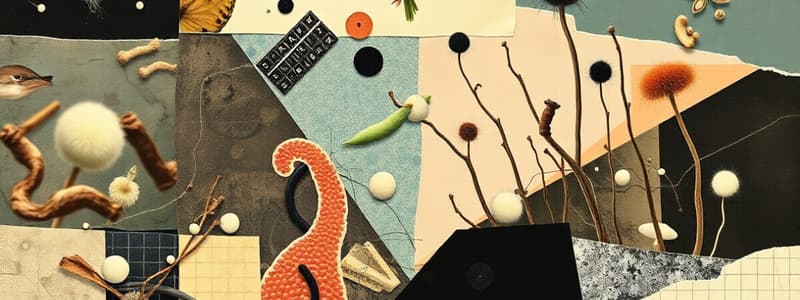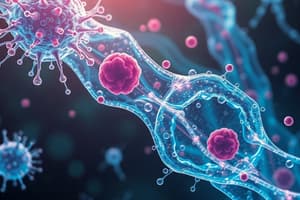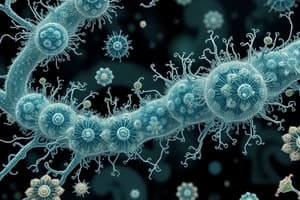Podcast
Questions and Answers
Which of the following is NOT a characteristic of prokaryotic cells?
Which of the following is NOT a characteristic of prokaryotic cells?
- Lack a true nucleus
- Have membrane-bound organelles (correct)
- Are typically smaller than eukaryotic cells
- Can be found in extreme environments
What is the term used to describe the process by which some bacteria form spores under unfavorable conditions?
What is the term used to describe the process by which some bacteria form spores under unfavorable conditions?
- Conjugation
- Transduction
- Sporulation (correct)
- Binary fission
Which of the following organisms are classified as eukaryotes?
Which of the following organisms are classified as eukaryotes?
- Bacteria and viruses
- Prions and viroids
- Archaea and fungi
- Algae and protozoa (correct)
Which branch of microbiology focuses on the study of microorganisms involved in food production and preservation?
Which branch of microbiology focuses on the study of microorganisms involved in food production and preservation?
Which of the following is an example of a non-cellular microorganism?
Which of the following is an example of a non-cellular microorganism?
What is the primary function of algae in the environment?
What is the primary function of algae in the environment?
Which of the following is a characteristic shared by bacteria and archaea?
Which of the following is a characteristic shared by bacteria and archaea?
What is the primary difference between a virus and a viroid?
What is the primary difference between a virus and a viroid?
Which of the following is a common application of biotechnology in the field of microbiology?
Which of the following is a common application of biotechnology in the field of microbiology?
What is the term for the study of the immune system and its response to infectious agents?
What is the term for the study of the immune system and its response to infectious agents?
Which of the following is NOT an example of a fomite?
Which of the following is NOT an example of a fomite?
Which of the following is an example of a disease that is commonly transmitted through droplet transmission?
Which of the following is an example of a disease that is commonly transmitted through droplet transmission?
Which of the following is NOT a characteristic of normal flora?
Which of the following is NOT a characteristic of normal flora?
Which of the following is an example of a disease that is commonly transmitted through bodily fluids?
Which of the following is an example of a disease that is commonly transmitted through bodily fluids?
Which of the following is an example of a disease that is commonly transmitted through water-borne or food-borne transmission?
Which of the following is an example of a disease that is commonly transmitted through water-borne or food-borne transmission?
Which of the following is NOT an example of an application of applied microbiology?
Which of the following is NOT an example of an application of applied microbiology?
Which of the following is an example of a biological vector?
Which of the following is an example of a biological vector?
Which of the following is an example of a disease that is commonly transmitted through direct contact?
Which of the following is an example of a disease that is commonly transmitted through direct contact?
What is the main difference between droplet transmission and airborne transmission?
What is the main difference between droplet transmission and airborne transmission?
What is a potential benefit of having transient flora in the human body?
What is a potential benefit of having transient flora in the human body?
What is the primary function of the Golgi apparatus?
What is the primary function of the Golgi apparatus?
Which of the following is NOT a function of the complement system in nonspecific defense?
Which of the following is NOT a function of the complement system in nonspecific defense?
Which type of cell is responsible for producing antibodies?
Which type of cell is responsible for producing antibodies?
What is the main difference between nonspecific and specific defense mechanisms?
What is the main difference between nonspecific and specific defense mechanisms?
Which of the following is NOT a sign or symptom of inflammation?
Which of the following is NOT a sign or symptom of inflammation?
What is the role of memory T-cells in cell-mediated immunity?
What is the role of memory T-cells in cell-mediated immunity?
Which of the following is a characteristic of a localized inflammatory response?
Which of the following is a characteristic of a localized inflammatory response?
Which of the following is a type of phagocyte found in the liver?
Which of the following is a type of phagocyte found in the liver?
What is the main function of cilia in the respiratory tract?
What is the main function of cilia in the respiratory tract?
Which of the following is a characteristic of smooth endoplasmic reticulum?
Which of the following is a characteristic of smooth endoplasmic reticulum?
Flashcards
Transient Flora
Transient Flora
Microorganisms that remain for a short time before disappearing, like Bacillus Laterosporus.
Normal Flora
Normal Flora
Microorganisms that normally live in the body and protect against disease in healthy individuals.
Opportunistic Pathogens
Opportunistic Pathogens
Normal flora that can cause diseases if the body's balance is disturbed.
Contact Transmission
Contact Transmission
Signup and view all the flashcards
Droplet Transmission
Droplet Transmission
Signup and view all the flashcards
Airborne Transmission
Airborne Transmission
Signup and view all the flashcards
Water-borne Transmission
Water-borne Transmission
Signup and view all the flashcards
Bodily Fluid Transmission
Bodily Fluid Transmission
Signup and view all the flashcards
Vector Transmission
Vector Transmission
Signup and view all the flashcards
Applied Microbiology
Applied Microbiology
Signup and view all the flashcards
Microbiology
Microbiology
Signup and view all the flashcards
Microorganisms
Microorganisms
Signup and view all the flashcards
Bacteria
Bacteria
Signup and view all the flashcards
Archaea
Archaea
Signup and view all the flashcards
Fungi
Fungi
Signup and view all the flashcards
Viruses
Viruses
Signup and view all the flashcards
Endospores
Endospores
Signup and view all the flashcards
Taxonomy
Taxonomy
Signup and view all the flashcards
Biotechnology
Biotechnology
Signup and view all the flashcards
Sporulation
Sporulation
Signup and view all the flashcards
Germination
Germination
Signup and view all the flashcards
Mitochondria
Mitochondria
Signup and view all the flashcards
Ribosomes
Ribosomes
Signup and view all the flashcards
Endoplasmic Reticulum (ER)
Endoplasmic Reticulum (ER)
Signup and view all the flashcards
Golgi Apparatus
Golgi Apparatus
Signup and view all the flashcards
Phagocytosis
Phagocytosis
Signup and view all the flashcards
Inflammation
Inflammation
Signup and view all the flashcards
T-cells
T-cells
Signup and view all the flashcards
B-cells
B-cells
Signup and view all the flashcards
Study Notes
Microbiology
- Study of organisms too small to be seen without magnification
- Originated with invention of the microscope
- Microorganisms include bacteria, viruses, fungi, protozoa, helminths (worms), algae, and prions
Branches of Study
- Immunology
- Public health microbiology and epidemiology
- Food, dairy, and aquatic microbiology
- Biotechnology
- Genetic engineering and recombinant DNA technology
- Manipulating genes
Microbes' Roles
- Nutrient production and energy flow
- Decomposition
- Biotechnology (food, drugs, vaccines)
- Genetic engineering
- Bioremediation
- Infectious disease
Classification of Microorganisms (Protists)
I- Cellular
- Prokaryotes: No nucleus or primitive nucleus (pro = before, early; karyon = nucleus)
- Examples: Archaea, bacteria, blue-green algae
- Eukaryotes: Mature nucleus
- Examples: Algae (other than blue-green algae), fungi, protozoans
II- Non-Cellular
- Viruses, viroids, prions
- Taxonomy: Formal system of organizing, classifying, and naming living organisms
Types of Organisms
- Bacteria: Prokaryotic, unicellular organisms
- Archaea: Prokaryotic, unicellular organisms living in highly salty or extreme temperature environments
- Algae: Eukaryotic organisms, performing photosynthesis
- Fungi: Eukaryotic, unicellular or multicellular organisms
- Protozoa: Eukaryotic, unicellular or multicellular organisms
- Viruses: Noncellular, seen only by electron microscopy; consist of NA (nucleic acid) surrounded by a protein coat
Bacterial Life Cycle
- Vegetative Form: Metabolically active, growing, multiplying, causing infection
- Spore Form: Inert, resting, non-growing, non-multiplying, highly resistant form; can live for years
- Germination: Spore form changes into vegetative form when environmental conditions improve
Cytoplasmic Organelles
- Mitochondria: Long, fluid-filled sacs producing ATP
- Ribosomes: Small granules of RNA, some free in cytoplasm, others attached to endoplasmic reticulum (ER); for protein synthesis
- Endoplasmic Reticulum (ER):
- Smooth ER: functions in lipid synthesis
- Rough ER: functions in protein synthesis (for transport)
- Golgi Apparatus: Flat sacs, connected to the ER, a shipping center
- Lysosomes: Sacs containing digestive enzymes
- Centrioles: Two rods at right angles, function in cell division
- Cilia: Short, numerous, hair-like processes that move substances across a cell surface
- Flagella: Long, few; move the cell
- Chloroplasts: In algae and plant cells; convert sun energy into chemical energy via photosynthesis
Defense Mechanisms Against Infection
- Nonspecific Mechanisms: Act against all harmful agents, provide nonspecific resistance
- Specific Mechanisms: Act against certain agents, provide specific resistance (immunity); lack of resistance is susceptibility; virulence is the degree of pathogenicity of a specific microbe
Modes of Transmission
- Contact: Direct (touching, kissing); Indirect (fomites)
- Droplet: Infectious agents transmitted via respiratory droplets (travel less than 1 meter)
- Airborne: Organisms travel more than a meter
- Water-borne & Food-borne: Through untreated/poorly treated sewage and/or food
- Vector: Animals, especially arthropods (biological or mechanical vectors)
- Bodily Fluid: Blood, urine, saliva, other bodily fluids
Applied Microbiology
- Food production (yogurt, bread, alcoholic beverages)
- Water treatment
- Pharmaceutical agents (penicillin)
- Agriculture (fertilizers)
- Bioremediation (petroleum)
- Forensics (medicine, bioterrorism)
- Energy (ethanol, methane)
Studying That Suits You
Use AI to generate personalized quizzes and flashcards to suit your learning preferences.




